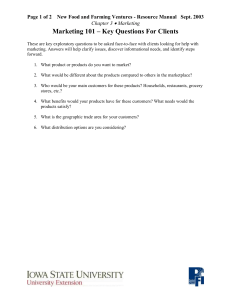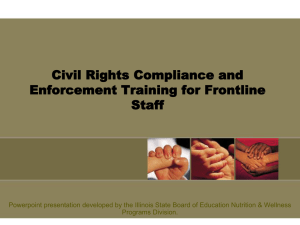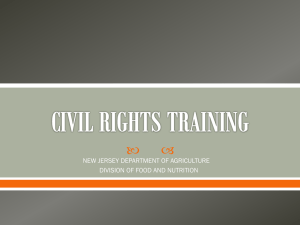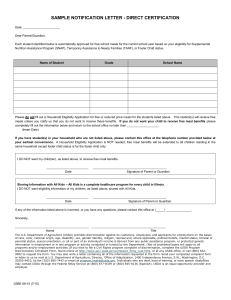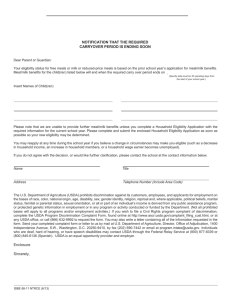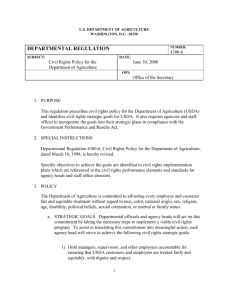Civil Rights Compliance and Enforcement Training For Administrators
advertisement
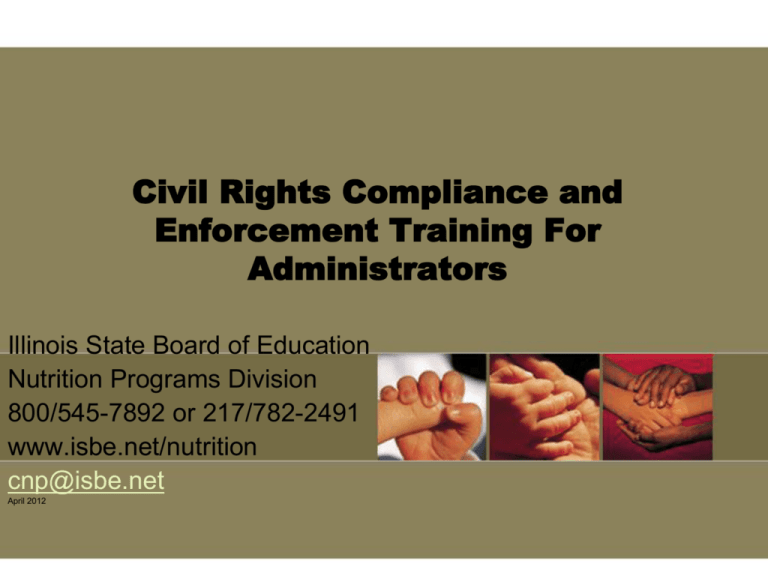
Civil Rights Compliance and Enforcement Training For Administrators Illinois State Board of Education Nutrition Programs Division 800/545-7892 or 217/782-2491 www.isbe.net/nutrition cnp@isbe.net April 2012 What Is Discrimination? Discrimination is defined as different treatment which makes a distinction of one person or a group of persons from others; either intentionally, by neglect, or by actions or lack of actions based on . . . United States Department of Agriculture (USDA) program statutes and regulations prohibit discrimination in Child Nutrition Programs based on: Race Color National origin Sex Age Disability What Is a Protected Class? Any person or group of people who have characteristics for which discrimination is prohibited based on a law, regulation, or executive order. Protected classes in special Nutrition Programs are race, color, national origin, age, sex, and disability. History Lesson: Where Did Our Current Laws Originate? Civil Rights Laws • Title VI—Civil Rights Act of 1964—Prohibits discrimination based on race, color, and national origin. • Title IX of the Education Amendments of 1972— Prohibits discrimination based on sex under any education program or activity that is receiving federal financial assistance. • Section 504 of the Rehabilitation Act of 1973— Prohibits discrimination based on disability. Civil Rights Laws (continued) • Americans With Disabilities Act of 1990— Prohibits discrimination based on a disability. • Age Discrimination Act of 1975—This Act clarifies and elaborates on the original Civil Rights Act of 1964 by ensuring nondiscrimination in all programs and activities. • Civil Rights Restoration Act of 1987— Prohibits discrimination based on race, color, and national origin. Goals of Civil Rights • Equal treatment for all applicants and beneficiaries • Knowledge of rights and responsibilities • Elimination of illegal barriers that prevent or deter people from receiving benefits • Dignity and respect for all Civil Rights Components I. Assurances II. Data collection and analysis III. Compliance reviews IV. Complaints investigation V. Outreach and education VI. Technical assistance and training VII. Reasonable accommodation VIII. Customer service I. Assurances • Assurances are contractual agreements in which a state agency, local agency, or the subrecipient legally agrees to administer FNS programs in accordance with all laws, regulations, instructions, policies, and guidance related to nondiscrimination. • Compliance is verified through compiling data, maintaining records, and submitting required reports. II. Data Collection and Reporting Sites need to establish a system to collect racial and ethnic data. • Self-identification preferred; for example, on the household application. • Alternatively, staff can make an observation of ethnicity and race. RATIONALE: Discrimination is often based on perception, and others would probably have a similar perception to the person doing the coding. Data Collection and Reporting (continued) • Collect ethnicity data first, then race data • Ethnicity categories – Hispanic or Latino – Non-Hispanic or Latino • Race Categories – – – – – American Indian or Alaskan Native Asian Black or African American Native Hawaiian or Other Pacific Islander White Data Collection and Reporting (continued) Why do I have to collect racial and ethnic data? The data is used to determine how effectively your program is reaching potentially eligible children and where outreach may be needed. How long do I have to keep the data? • Three years plus the current year • Data should be kept secure and confidential III. Compliance Reviews Purpose: to determine if the applicant or recipient of Federal financial assistance is in compliance with civil rights requirements. Types of Compliance Reviews • Pre-Award Reviews—Take place before the site is approved for operation. • Post-Award Reviews—Take place after a site has been approved for operation. • Special Reviews—Take place after a site has been approved due to a complaint, data collection, or as follow-up to previous non-compliance. Complaint Investigations Who do I contact? If you wish to file a Civil Rights program complaint of discrimination, complete the USDA Program Discrimination Complaint Form, found online at http://www.ascr.usda.gov/complaint_filing_cust.html, or at the USDA office, or call (866)632-9992 to request the form. You may also write a letter containing all of the information requested in the form. Send your completed complaint form or letter to us by mail at U.S. Department of Agriculture, Director, Office of Adjudication, 1400 Independence Avenue, S.W., Washington, D.C. 20250-9410, by fax (202)690-7442 or email at program.intake@usda.gov. Individuals who are deaf, hard of hearing or have speech disabilities may contact USDA through the Federal Relay Service at (800)877-8339; or (800)845-6136 (Spanish). V. Outreach and Education Are Important Because: • You want to reach as many potential eligibles as possible • You want to ensure program access • You need to pay attention to underrepresented groups • You need to ensure information is available in other languages as needed Public Notification System All sites must provide informational materials in the appropriate translation concerning the availability and nutritional benefits of the meal programs (NSLP, SBP, SMP, ASP, CACFP). Outreach and Education Include non-discrimination statement on all materials that mention USDA programs (including websites). However, you do not need to include the statement on your menus. Outreach and Education Non-Discrimination Statement The U.S. Department of Agriculture prohibits discrimination against its customers, employees, and applicants for employment on the bases of race, color, national origin, age, disability, sex, gender identity, religion, reprisal, and where applicable, political beliefs, marital status, familial or parental status, sexual orientation, or all or part of an individual’s income is derived from any public assistance program, or protected genetic information in employment or in any program or activity conducted or funded by the Department. (Not all prohibited bases will apply to all programs and/or employment activities.) If you wish to file a Civil Rights program complaint of discrimination, complete the USDA Program Discrimination Complaint Form, found online at http://www.ascr.usda.gov/complaint_filing_cust.html, or at the USDA office, or call (866)632-9992 to request the form. You may also write a letter containing all of the information requested in the form. Send your completed complaint form or letter to us by mail at U.S. Department of Agriculture, Director, Office of Adjudication, 1400 Independence Avenue, S.W., Washington, D.C. 20250-9410, by fax (202)690-7442 or email at program.intake@usda.gov. Individuals who are deaf, hard of hearing or have speech disabilities may contact USDA through the Federal Relay Service at (800)877-8339; or (800)845-6136 (Spanish). USDA is an equal opportunity provider and employer. Outreach and Education When using graphics, reflect diversity and inclusion. The USDA And Justice for All Poster • Prominently display this poster in each food service area so it is visible to participants • Posters are available free of charge from ISBE. Email: cnp@isbe.net or telephone 800/5457892 or 217/782-2491 Limited English Proficiency (LEP) Definition: • Individuals who do not speak English as their primary language and have a limited ability to read, speak, write, or understand English. • Recipients of Federal financial assistance have a responsibility to take reasonable steps to ensure meaningful access to their programs and activities by persons with LEP. LEP (continued) Primary factors to consider when determining reasonable steps: • Number of proportion of LEP persons in the eligible service population – The greater the number, the higher the need • Frequency of contact in the programs – Can do outreach • Importance of the service provided by the programs • Resources available to the recipient/costs LEP (continued) • NSLP household applications in other languages can be found at www.fns.usda.gov/cnd/FRP/frp.process.htm. • Further information on LEP is available at www.LEP.gov. VI. Civil Rights Training Technical Assistance and Training • Training is required annually for frontline staff. • Teaching tools available on our website: – This PowerPoint™ presentation – Front-line staff PowerPoint™ presentation – Civil rights requirements handouts available by program type VII. Reasonable Accommodation ENSURE ACCESS FOR PEOPLE WITH DISABILITIES! • Parking lot, entrances and exits, halls, elevators, rest rooms, sign language interpreters, Braille signage, and service animals • Alternative arrangements for service VIII. Customer Service PLATINUM RULE Treat others the way they want to be treated (or at least be aware of what that is). Training Tips • Cover the basics • Provide an understanding of the origin of the requirements (i.e., laws that cover all federally-funded entities) • Recognize and value differences • Use relevant examples and situations to illustrate concepts School-Based Child Nutrition Scenario #1 Through your data collection procedures, you recognized that even though the community is composed of a large Hispanic population (40 percent), only 2 percent of Hispanics are eligible for meal benefits. What outreach efforts would you take to increase Hispanic program participation? Answer to Scenario #1 • Good job on data collection! • Educational information or materials may be needed in other languages. • Provide outreach to other programs in the area which serves the Hispanic population. • There are many outreach efforts which could increase program participation. Such as partnering with Social Service Agencies and working with neighborhood groups. School-Based Child Nutrition Scenario #2 On occasion, the cafeteria will have leftovers following the last lunch period and will offer them to the boys in the group. Is this practice discriminatory and if so on what basis? Answer to Scenario #2 • Yes, it is discriminatory. Even though cafeteria staff may not intentionally be discriminating against anyone, they are discriminating based on sex. • If leftovers are gong to be offered they need to be offered to everyone. School-Based Child Nutrition Scenario #3 “Pizza Day” is the most popular day in the school cafeteria. Near the end of the lunch period three African-American boys come through the line and are told by a Caucasian school lunch employee that the cafeteria is “out of pizza.” They can see two pieces of pizza remain. School-Based Child Nutrition Scenario #3 (continued) Shortly thereafter, a Caucasian boy comes through the line and the school lunch employee gives him one of two remaining pieces of pizza. You ask the employee why he gave the Caucasian child a piece of pizza after he told the three African-American children the cafeteria was out. The employee tells you the Caucasian child is his neighbor and he promised the child he would save him a piece of pizza the next time it was served in the cafeteria. Answer to Scenario #3 • Even though the cafeteria worker probably thought they were just being nice and saving a piece of pizza for the neighbor boy, it definitely looks discriminatory. • The two slices of pizza should go to the first two children through the line that ask for it. School-Based Child Nutrition Scenario #4 From time to time the cafeteria will have leftovers after the final lunch period. With your permission, cafeteria servers are allowed to offer students a second helping. All three cafeteria servers are known to be big boosters of the high school football team and only offer leftovers to football players. • Is this practice permissible under the Civil Rights Act? • On what basis is this practice discriminatory? Answer to Scenario #4 This is a tricky one. Yes, it is permissible. It is not discriminatory based on sex because by law girls can be on the football team and sports teams are not a protected class. Therefore, this is not discrimination. Child Nutrition Scenario #1 A family does not want to identify their race or ethnic background on the household application. What should the center staff do? Answer to Child Nutrition Scenario #1 • Staff should explain to the family that self identification is voluntary. Program applicants or participants are NOT required to furnish information on their race or ethnicity. When an applicant does not provide the information the data collector must, through visual observation, record the information for them. • Center staff can point out that the collection of this information is strictly for statistical reporting requirements and has no effect on determining their eligibility. Child Care Scenario #1 A child care center does not provide infant foods and/or formula to infants in their care and requires parents to supply these items. Is this a civil rights issue? Answer to Child Care Scenario #1 Yes. All children who attend a center must be provided equal access to the benefits of the CACFP. Therefore, infant formula and food must be offered to infants at the center and parents cannot be asked or required to supply these items. To withhold the program from any eligible age group is age discrimination. Child Care Scenario #2 Children whose first language is Spanish are asked to sit together at a Spanishspeaking table. Is this a civil rights issue? Answer to Child Care Scenario #2 Yes, segregating or separating children who share a particular characteristic into groups would be considered a civil rights issue and discrimination based on the protected class of national origin. NOTE: Be careful of implied segregation, such as seating all boys or girls at separate tables. This is a questionable practice unless it is done for disciplinary or other legitimate reasons. In the End . . . Memories of our lives, of our works, and our deeds will continue in others, who believe and act for fairness and justice. Rosa Parks 1913–2005
